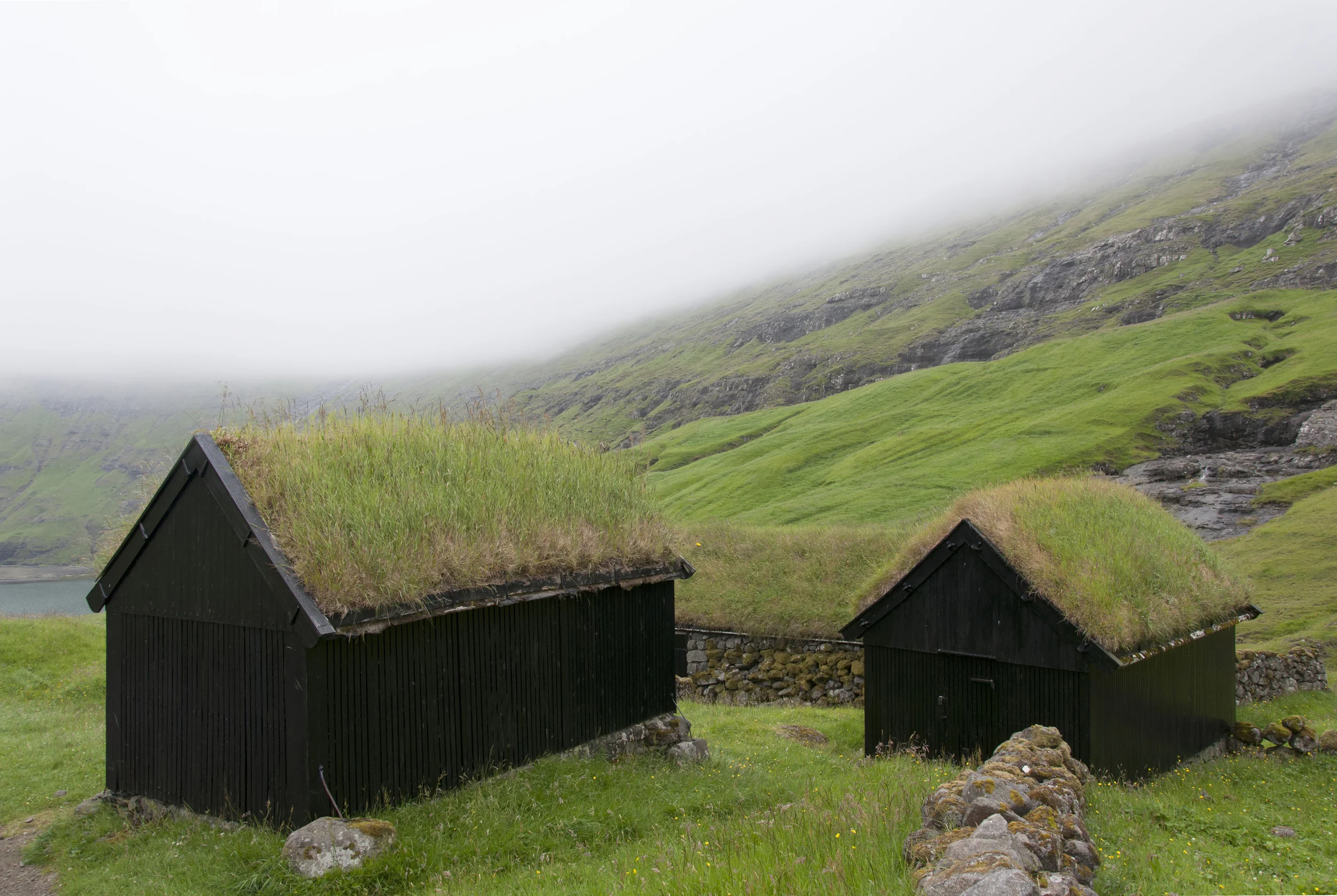The Faroe Islands appear as mountaintops that rise directly from the sea. My arrival was greeted by fog and as I biked the underside of the fog served as my datum, not the sea itself. As the fog lifted the role of the sea became evident.
The people occupy the liminal space along the coast with a tenacity that is palpable. The roads that trace the coast are punctuated by towns that seem born of a similar recipe: waterfall, modest port, memorial to lost fishermen, colorful homes, church, cemetery, and two vernacular, utilitarian structures: one wooden and one stone.
Saksun, Faroe Islands
hjallur :: used in the preparation of the wind-dried mutton delicacy skerpikjøt
boat storage structure :: Vágar, Faroe Islands
Hjallur are wooden structures with gabled roofs. The walls are wooden slats that allow the salty sea air to pass through them. In the Faroe Islands they are typically painted black. For five to nine months, mutton shanks are hung within the structures; the wind-dried meat is called skerpikjøt. (Typically eaten at Christmas, I was fortunate to have the opportunity to taste skerpikjøt; it was lovely.) The experiential quality of the hjallur are striking. Four walls with alternating black-painted wooden slats and open space created an every changing opacity as one moved around the buildings. You could read the interior structure. They appeared unexpectedly backlit. You were able to glimpse tiny, indiscernible fractured framed views. I am still searching for the proper term to describe it; twinkle is too juvenile, shimmer too cute, but there is a magic to it. It may be the world’s most beautiful pantry.
The stone structures appear more flexible in their programming. Their overarching classification is storage. The type of storage was dictated by site and ranged from hay to boats. Four walls of dry-stacked stone were roofed with wooden rafters and covered in turf. In some instances a layer of birch bark served as a waterproofing barrier between structure and insolation. The birch bark extended beyond the turf to form a drip edge. The stone structures had a sense of being ancient. They were not in ruin or disuse, but currently used and clearly cared for.
In both cases the buildings are embed within the village fabric. Hjallur seem tied to the neighboring residence. The stone structures, more durable in construction, were granted a larger radius to roam. They could be found from the water’s edge to far inland amongst the sheep and fields.
Vágar, Faroe Islands
Gjógv, Faroe Islands
Gjógv, Faroe Islands
But the people, the people live along the coast. Life, industry and death share the liminal space. Each town has a church located near the shore. It was explained to me that the siting of the churches was to allow for loved ones to pray for their venturing fishermen. Cemeteries are also located right at the water’s edge, typically surrounded by a low wall, a reminder of the danger inherent in the sea. The sheer, craggy cliffs are occupied as well. Men repel down the cliff faces to hunt birds and herd sheep. While on a boat tour the captain relayed, with a hauntingly casualness, the cliffs that were used in this fashion. Necks craned, mouths agape; my respect for the Faroese was solidified.
I inadvertently ended up in the Faroe Islands during Ólavsøka, their largest national holiday. I was surrounded by traditional Faroese dress, singing, dancing and a general merriment that is beyond words. It was during the celebration that I was given the name of two boat builders, Jóan Petur Clementsen and his father, Marius Clementsen. I was told only their names and which island they resided on. Fortunately, in a country with a population of approximately 50,000 people, that is all you need.
I arrived at his island armed only with his name. Three short conversations later I arrived at Jóan Petur’s door. He greeted me warmly and spent the better part of a day discussing boats, boat building, tools and trades. I joined his family for the annual task of gathering the newly dried hay for the winter. We shared a meal, talked politics and toured a neighboring village. I had showed up unexpectedly and he and his wife welcomed me with a warmly into their home and their day.
I left the Faroe Islands completely charmed.
::
I would be remiss if I did not mention a presence that currently exists in the Islands. I mention it because it colored my experience, not because I think it is a conversation worthy of discourse. There is a group that operates under the guise of environmental activism and they occupy the country for approximately three months a year. I use the term occupy intentionally as the band has a quasi-military feel:
they are uniformed,
they patrol,
they stake out vantage points,
they employ propaganda.
I will not name the organization, as I do not intend to provide them another platform. But I do question their agenda. The founder has garnered fame. Their ‘non-profit’ is well funded by foreign donations. They receive celebrity endorsements. I question their intentions because I am suspicious of their targeted audience.
they have named themselves in English.
had they really intended to engage in a dialogue with the Faroese people,
they would have named themselves in Faroese.






